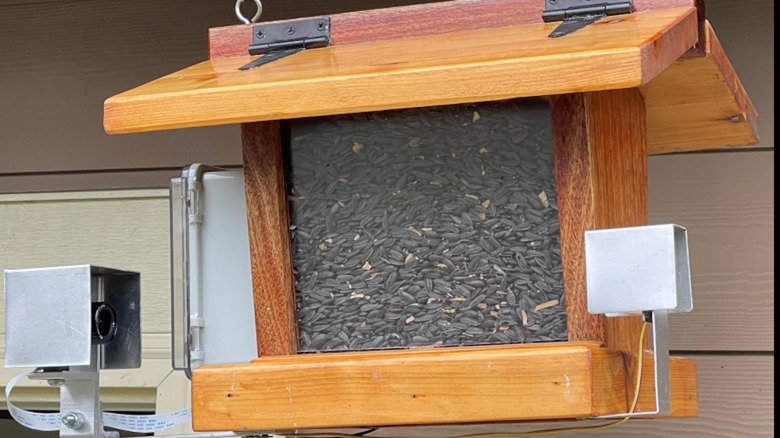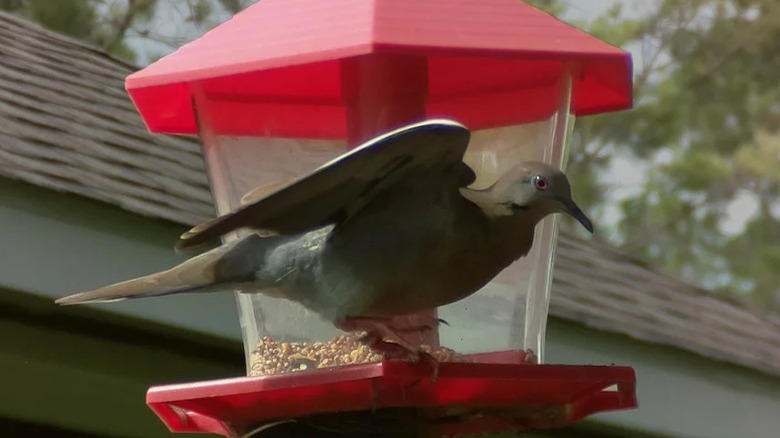You Should Make Your Own Smart Bird Feeder With Raspberry Pi: Here's Why
Everything from coffee makers to home hydroponics systems seems equipped with hardware that allows them to be controlled via smart home ecosystems, but plenty of items don't come with smart controls. That hasn't stopped people from converting them, though. Hobbyist engineers have found clever ways to smarten up everyday devices using the Raspberry Pi. These tiny computers' size, versatility, and affordability have inspired numerous makers to use them as command receivers and control centers for their devices.
That's how Jeff Stockman, a student at the University of Washington, came to create a smart bird feeder for his "Internet of Things" course. "It uses an ultrasonic ranger to detect the presence of a bird," Jeff explained in an interview with The MagPi Magazine. "This detects the distance of the bird from the feeder, and when it decreases below 14 centimeters, it triggers the camera to snap a photo. Once the bird is more than 14 centimeters away, the camera is ready to take a photo again."
These photos are then connected to the Raspberry Pi, which relays that information to the home computer. Other makers have designed similar models using 3D-printed housings and other components. Tom's Hardware reported that a maker named Hermy65 created one that works in conjunction with the Raspberry Pi Global Shutter Camera. Autodesk Instructables user "sbkirby" posted instructions for how to make one that uses an Adafruit CAP1188 capacity touch sensor to detect when birds land.
A smart birdhouse might seem like one of the more unusual Raspberry Pi projects, but there are a few good reasons for making your own.
See the birds you missed
Most of the time, people set up bird feeders because they are looking to see some birds. You can't be staring out your window all the time, though, so you are bound to miss at least a few of your feathered friends who drop by your birdhouse. Smart bird feeders allow you to see every member of the avian community who comes for a visit. Some of these designs can also identify the birds they take photos of.
There might be a few bird watchers who recognize every fowl they see at a glance, but most of us need a little help with the more exotic varieties. Luckily, the software Stockman programmed for his smart bird watcher uses the free tier of the Microsoft Azure Custom Vision machine learning service. This pulls from similar images to help bird watchers identify their winged guests.
Stockman explained that he trained his model by pulling 20-25 photos from Google Images for each popular bird species that would come to his feeder, using this information to train Azure to tag each photo by species. Stockman admitted that this method isn't 100% foolproof, but it does help with the identification and categorization of local species.
Of course, anyone setting up one of these smart bird feeders will have to train their own modules to recognize the birds that live and migrate through their area.
Help track bird migrations
Setting up a smart birdhouse is great for those who want to get a few snapshots of hungry birdies for themselves, but it's also useful for science. Stockman's original inspiration for the project was the Great Backyard Bird Count, a four-day global event that takes place every February. It was launched in 1998 by the Cornell Lab of Ornithology and National Audubon Society and was later joined by Birds Canada in 2009. People worldwide count and report local birds during this time to help these societies track bird migrations.
Most contributors usually just go bird-watching and then report what they see out in the wild using the eBird app. However, using a smart birdfeeder can automate the task while providing verifiable photo evidence that can be very useful for tracking birds migrating outside their usual paths. According to the Smithsonian's National Zoo and Conservation Biology Institute, "Knowing birds' exact movements and locations improves the ability of conservation biologists and wildlife managers to protect birds and the places they rely on."
So, creating a smart bird feeder might actually help conservationists protect these birds from harm so that future generations might enjoy them. That's a pretty good reason to make one.


